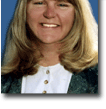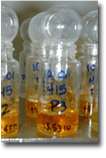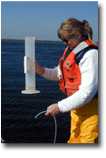| |
Cynthia
L. Brown
Physical Scientist
M.S., San Jose State University, Geology
clbrown@usgs.gov
Research Interests
My area of research is on the availability and effects of
inorganic trace elements in aquatic ecosystems. Current research
is on the uptake and effects of trace elements on biotic organisms
in San Francisco Bay, specifically the invasive clam Potamocorbula
amurensis. This long-term, ongoing study has contributed to
the understanding of processes that occur in complex estuaries.
This work will continue with other organisms in the San Francisco
Bay and Delta system. I am also interested in using a variety
of techniques to study the effects of contaminants on aquatic
organisms. These include physiological measurements (i.e.
heart rate, respiration) and life cycle stage development.
Selected Publications
Brown, C.L., Luoma, S.N., Parchaso,
F. and Thompson, J.K. 2004, Lessons Learned About Metals in
the Estuary:
The Importance of Long-term Clam Accumulation Data, Pulse,
Vol. 24, p. 38-45.
Brown, C.L., Parchaso,
F., Thompson, J.K. and Luoma, S.N., 2003, Assessing Toxicant
Effects in a Complex Estuary: A Case Study of Effects of Silver
on Reproduction in the Bivalve, Potamocorbula amurensis,
in San Francisco Bay, Human
and Ecological Risk Assessment, Vol. 9, No. 1, p. 95-119.
Brown, C.L. and Luoma, S.N., 1995, Energy-related
selenium and vanadium contamination in San Francisco Bay:
Effects on biological resources?, in Carter, L.M.H., ed.,
Energy and the Environment - Application of Geosciences to
Decision - Making. Program and short papers, Tenth Annual
McKelvey Forum on Mineral and Energy Resources, February 13
- 16, 1995, Washington D.C., U.S.
Geological Survey Circular 1108, p. 91-92.
Brown, C.L. and Luoma, S.N., 1995, Use
of the euryhaline bivalve Potamocorbula amurensis as a biosentinel
species to assess trace metal contamination in San Francisco
Bay. Marine
Ecology Progress Series. Vol. 124, No. 1-3, p. 129-142.
Teh, S.J., Clark, S.L., Brown, C.L.,
Luoma, S.N., and Hinton, D.E., 1999, Enzymatic and histopathologic
biomarkers as indicators of contaminant exposure and effect
in Asian clam (Potamocorbula amurensis). Biomarkers.
Vol. 4, No. 6, p. 497-509.
Brown, C.L. and Luoma, S.N., 1999,
Metal trends and effects in Potamocorbula amurensis in North
San Francisco Bay. U.S. Geological Survey Toxic Substances
Hydrology Program – Proceedings of the Technical Meeting,
Charleston, South Carolina, March 8-12, 1999, Water-Resources
Investigations Report 99-4018B, p. 17-21.
|





